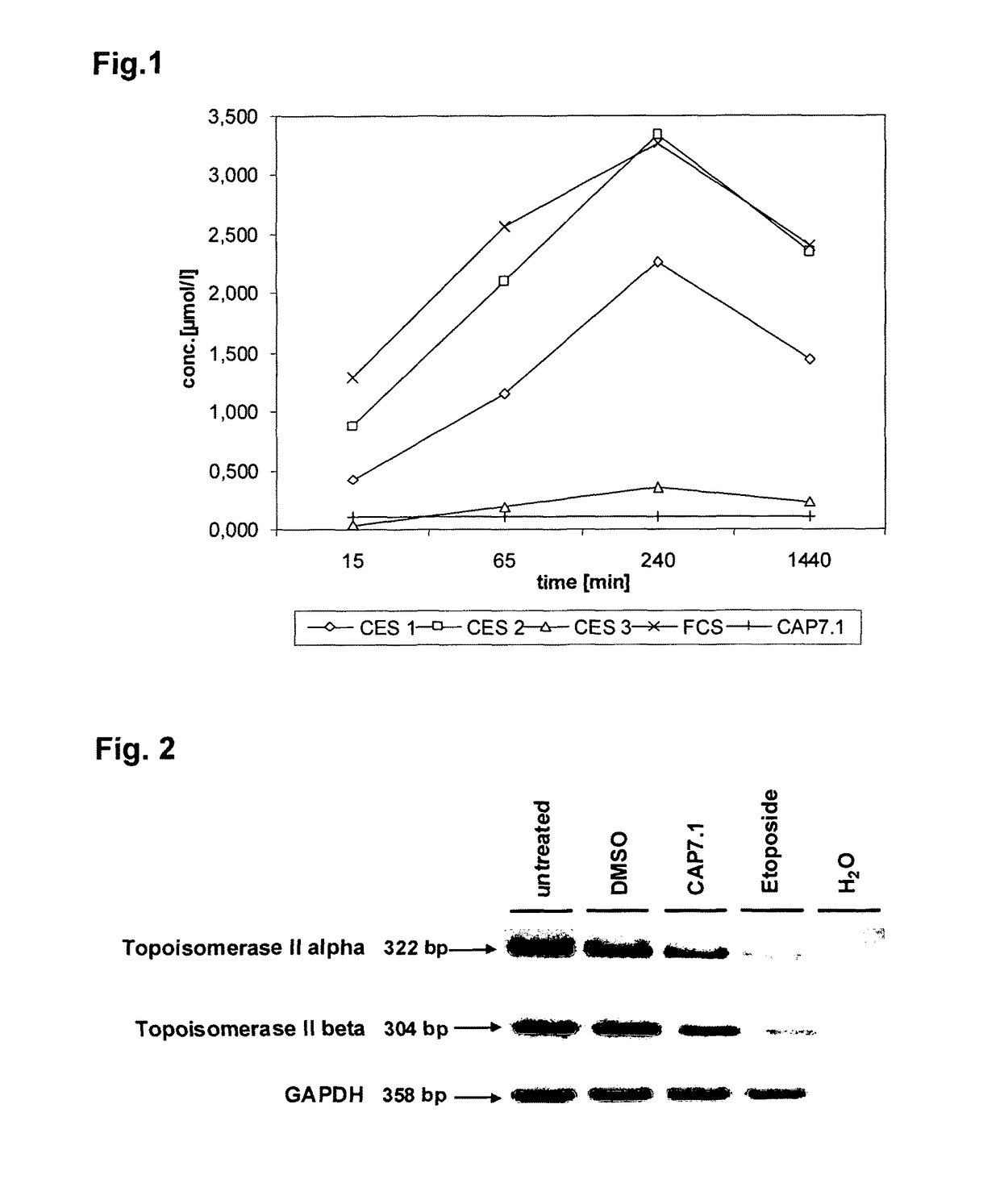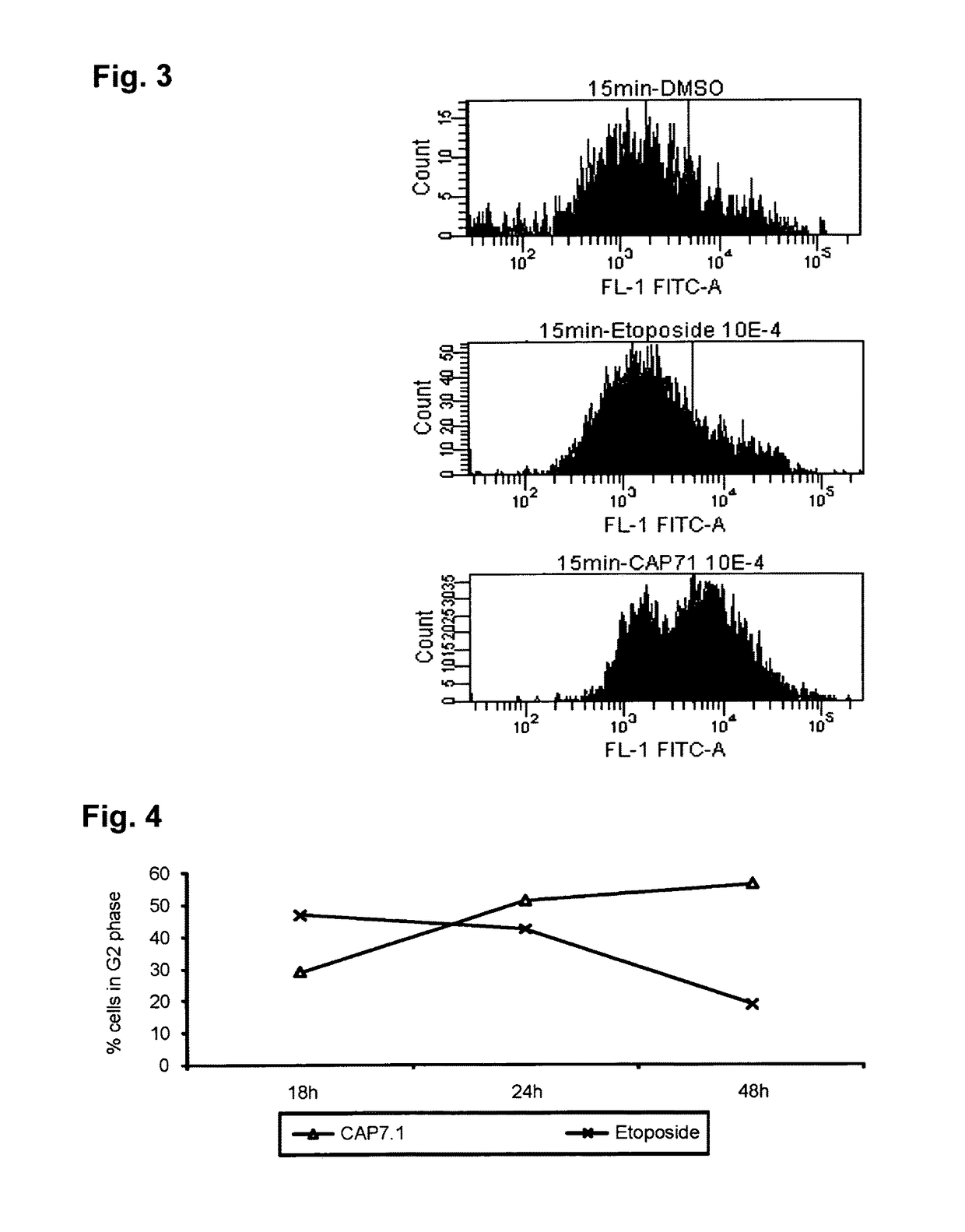Analogues of etoposide for the treatment of tumours
a technology of etoposide and tumour, which is applied in the direction of sugar derivatives, biocide, plant growth regulators, etc., can solve the problems of limiting the applicability of etoposide, multiple non-repairable double strand breaks, and poor water solubility, so as to delay the induction of apoptosis
- Summary
- Abstract
- Description
- Claims
- Application Information
AI Technical Summary
Benefits of technology
Problems solved by technology
Method used
Image
Examples
example 5
ity of CAP7.1 and of Etoposide on the Cell Line HT-29
DETAILED DESCRIPTION OF PREFERRED EMBODIMENTS
[0077]HT-29 cells, which are not multidrug-resistant, were grown in DMEM, 10% foetal calf serum, 2 mM glutamine and 100 U / l Pen / Strep medium and then washed. Cells were resuspended at a concentration of 106 cells / ml in medium as described above containing various concentrations of CAP7.1 and etoposide, respectively, ranging from 10−10 mol / l to 10−4 mol / l.
[0078]Cells were harvested, counted, and inoculated at the appropriate concentration of 104 cells / well (100 μl volume) into 96-well microtiter plates. After 24 h, the drugs were applied to triplicate culture wells, and cultures were incubated for given times at 37° C. XTT was prepared at 1 mg / ml in pre-warmed (37° C.) medium (RPMI 1640) without serum. PMS was prepared at 5 mmol / l (1.53 mg / ml) in PBS. Fresh XTT and PMS were mixed together at appropriate concentrations. For a 25 μmol / l XTT-PMS solution, 25 μl of the 5 mmol / l PMS solution ...
example 6
n of CES1 and CES2 in Tumour Cell Lines
[0080]Different cell lines responsive to compounds of formula (I) were tested for endogenous Expression of CES1 and CES2. Expression was quantified by real-time PCR.
[0081]Cells were harvested, counted, and inoculated at the appropriate concentration of 106 cells / well (2 ml volume) into 6-well plates with drugs for given time points at 37° C. RNA was extracted and cDNA was synthesized with random hexamers and TaqMan reverse transcriptase to be used in real-time PCR in a reaction with PCR buffer mix and specific primers for human CES1 and CES2.
[0082]The results for CAP7.1 obtained in the cell lines Raji, U-937 and HT-29 are illustrated in FIG. 6, which shows inverted ΔCT values.
[0083]Raji cells express only CES2. U-937 and HT-29 cells express both CES1 and CES2. Accordingly, these cells respond to treatment with compounds of formula (I), in particular CAP7.1.
example 7
CAP7.1 in Animal Studies
[0084]The objective of this study was to evaluate the potential modifications of cardiovascular function and cardiac electrophysiology by CAP7.1. The intravenous route was selected, as it is the intended mode of administration in human therapeutic use.
[0085]A total of four cynomolgus monkeys (two males and two females) were implanted with telemetric devices and allocated to a single group. They received a single dose of the vehicle (Cremophor / ethanol / NaCl) or CAP7.1, by intravenous 30-minute infusion. Cardiovascular parameters were monitored up to 24 hours following single infusion. The cardiovascular parameters evaluated in this study included heart rate, diastolic, systolic and mean arterial pressure, and duration of the PQ, QRS and QT intervals. CAP7.1 induced no relevant modifications in the cardiac electrophysiological parameters of conscious monkeys. No arrhythmias were observed.
[0086]The lack of cross-resistance to CAP7.1 of MDR-mediated etoposide-resi...
PUM
| Property | Measurement | Unit |
|---|---|---|
| Fraction | aaaaa | aaaaa |
| Electrical resistance | aaaaa | aaaaa |
| Therapeutic | aaaaa | aaaaa |
Abstract
Description
Claims
Application Information
 Login to View More
Login to View More - R&D
- Intellectual Property
- Life Sciences
- Materials
- Tech Scout
- Unparalleled Data Quality
- Higher Quality Content
- 60% Fewer Hallucinations
Browse by: Latest US Patents, China's latest patents, Technical Efficacy Thesaurus, Application Domain, Technology Topic, Popular Technical Reports.
© 2025 PatSnap. All rights reserved.Legal|Privacy policy|Modern Slavery Act Transparency Statement|Sitemap|About US| Contact US: help@patsnap.com



